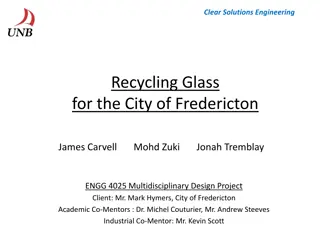
Flat Glass Market
The Global Flat Glass Market size is expected to be worth around USD 192.2 Billion by 2033, from USD 112.5 Billion in 2023, growing at a CAGR of 5.5% during the forecast period from 2024 to 2033.nClick here for request a sample : //market.us/repo
Download Presentation

Please find below an Image/Link to download the presentation.
The content on the website is provided AS IS for your information and personal use only. It may not be sold, licensed, or shared on other websites without obtaining consent from the author. If you encounter any issues during the download, it is possible that the publisher has removed the file from their server.
You are allowed to download the files provided on this website for personal or commercial use, subject to the condition that they are used lawfully. All files are the property of their respective owners.
The content on the website is provided AS IS for your information and personal use only. It may not be sold, licensed, or shared on other websites without obtaining consent from the author.
E N D
Presentation Transcript
The Global Flat Glass Market size is expected to be worth around USD 192.2 Billion by 2033, from USD 112.5 Billion in 2023, growing at a CAGR of 5.5% during the forecast period from 2024 to 2033. The flat glass market encompasses the production and distribution of glass products that are manufactured in flat, smooth sheets. This includes a range of applications such as windows, mirrors, glass facades, and interior partitions in residential, commercial, and automotive sectors. Flat glass is valued for its clarity, strength, and versatility, making it essential for architectural and functional uses. The market is influenced by construction trends, technological advancements in glass manufacturing, and increasing demand for energy-efficient and aesthetically pleasing building materials. Market Key Players: Asahi Glass Nippon Sheet Glass Guardian Industries Saint-Gobain AGC Inc. Cardinal Glass Industries Inc. Nippon Sheet Glass Co. Ltd China Glass Holdings Limited Fuyao Glass Industry Group Co., Ltd. Guardian Industries Sisecam Other Key Players Click here for request a sample : https://market.us/report/flat-glass-market/request-sample/ Product Analysis: Toughened glass leads the flat glass market with a 36.3% share due to its superior strength and safety features. Processed through thermal tempering, it is four times stronger than
regular glass, making it ideal for high-rise buildings and automotive applications. Its durability supports modern architecture trends and stringent safety standards in vehicles. While other types like laminated, coated, and extra clear glass also play roles, toughened glass remains the dominant choice due to its high impact resistance and versatility. Technology Analysis: Sheet glass dominates the market with a 42.8% share, thanks to its cost-effectiveness and versatility. Produced through melting and floating processes, it is widely used in construction, mirrors, and picture frames. The high demand in construction, driven by urbanization and infrastructure development, fuels its growth. While other technologies like float and rolled glass serve niche markets, sheet glass's affordability and practicality make it the leading technology in the flat glass sector. Application Analysis: The building and construction sector leads the flat glass market with a 40.5% share, driven by urbanization and a push for energy-efficient buildings. Flat glass is essential for windows, facades, and partitions, supporting modern architectural trends and sustainable practices. As urbanization accelerates in emerging markets and green building standards become more stringent, the demand for flat glass continues to rise. Additionally, the automotive and solar glass segments also contribute to market growth, with increasing vehicle production and renewable energy adoption. Key Market Segments: By Product Type Toughened Glass Laminated Glass Coated Glass Extra Clear Glass Others By Technology Sheet
Float Rolled By Application Building & Construction Automotive Solar Glass Others Driving Factors: Increasing Construction Activities: The construction industry's demand for flat glass is rising due to urbanization and infrastructure development, especially in emerging economies like China and India. The growth is fueled by investments in residential, commercial, and industrial projects, as well as a push for energy-efficient and sustainable building practices. Technological advancements in glass, such as smart glass, are also driving this demand. Automotive Industry Growth: The flat glass market benefits from the automotive sector s expansion, with increased production and sales of vehicles. The rise in electric vehicles (EVs) and advanced automotive designs, which require innovative glazing solutions, further drives the need for flat glass. Technological innovations in automotive glass, including lightweight and shatterproof options, support this growth. Energy-Efficient Building Initiatives: There is a growing demand for energy-efficient glazing solutions driven by sustainability goals and regulatory standards. Innovations like low-emissivity (Low-E) glass help reduce energy consumption in buildings. As countries adopt stricter energy performance standards, such as the EU s nearly zero-energy requirement, the flat glass market sees increased demand. Restraining Factors:
Environmental Concerns: The flat glass industry faces high operational costs due to stringent environmental regulations, which require significant investment in emission control and energy-efficient technologies. These costs can burden smaller companies and slow market growth as they divert resources from innovation. Trade Barriers and Geopolitical Tensions: International trade issues, including tariffs and geopolitical tensions, impact the flat glass market by increasing costs and disrupting supply chains. Trade barriers, such as U.S. tariffs on Chinese flat glass, and political instability can hinder market growth and stability. Growth Opportunities: Smart Glass and Innovative Applications: Advances in smart glass technologies, such as electrochromic and photochromic glass, offer new growth opportunities. These products provide energy efficiency and comfort, fitting well into smart buildings and connected systems, thus driving market expansion. Sustainability and Circular Economy: Embracing sustainability and circular economy practices can enhance growth for flat glass manufacturers. By adopting eco-friendly production methods and recycling solutions, companies can meet global sustainability goals and attract environmentally conscious consumers, tapping into emerging markets. Trending Factors: Growth in the Automotive Industry: The automotive sector's rise, driven by advanced vehicle features and electric vehicles, boosts demand for flat glass. Manufacturers are focusing on producing high-performance, lightweight glass to meet the needs of modern vehicles. Expansion in Solar Energy Applications: The shift towards renewable energy is increasing the demand for flat glass in solar energy applications. Flat glass is crucial for photovoltaic (PV) modules, protecting and enhancing their efficiency, driven by global efforts to adopt sustainable energy solutions.






















